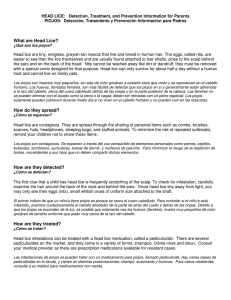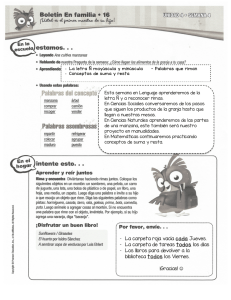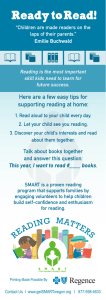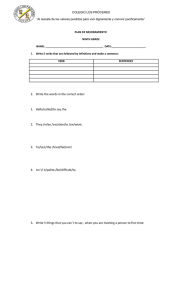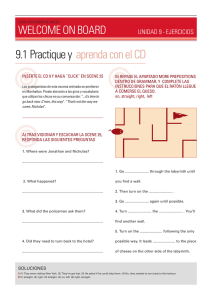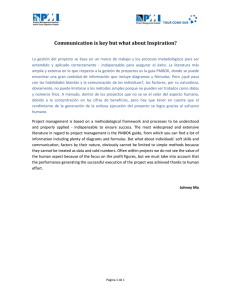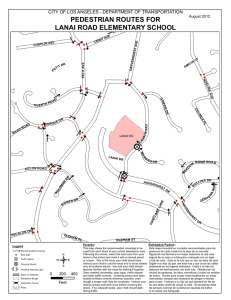Head Lice: A Real Head Scratcher
Anuncio
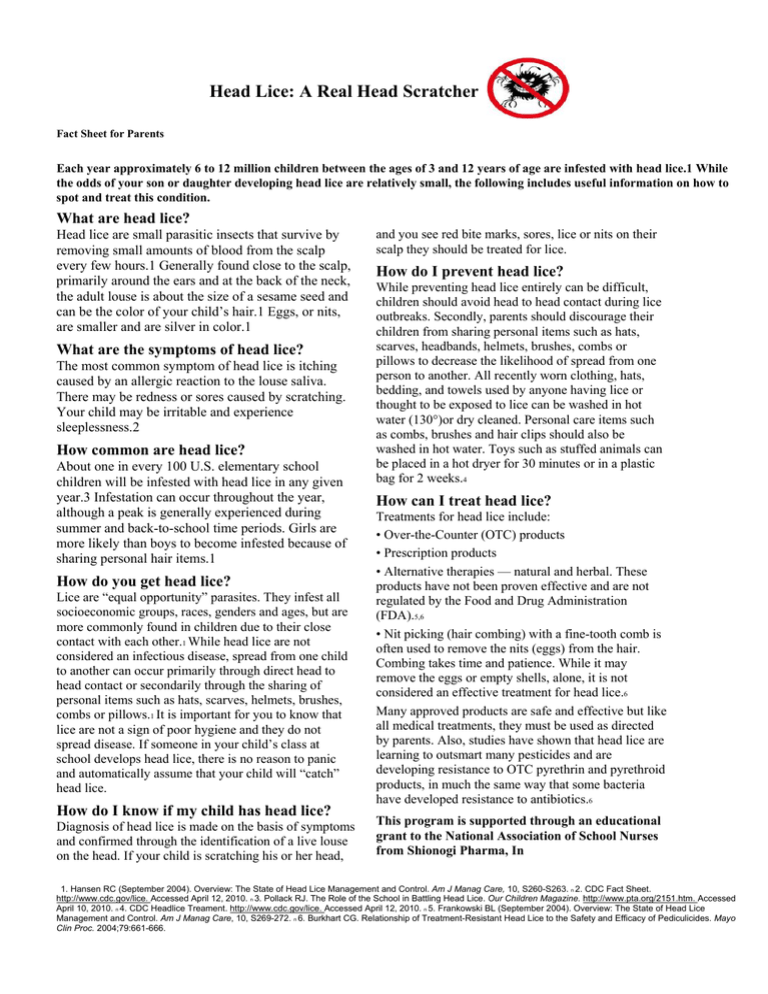
Head Lice: A Real Head Scratcher Fact Sheet for Parents Each year approximately 6 to 12 million children between the ages of 3 and 12 years of age are infested with head lice.1 While the odds of your son or daughter developing head lice are relatively small, the following includes useful information on how to spot and treat this condition. What are head lice? Head lice are small parasitic insects that survive by removing small amounts of blood from the scalp every few hours.1 Generally found close to the scalp, primarily around the ears and at the back of the neck, the adult louse is about the size of a sesame seed and can be the color of your child’s hair.1 Eggs, or nits, are smaller and are silver in color.1 What are the symptoms of head lice? The most common symptom of head lice is itching caused by an allergic reaction to the louse saliva. There may be redness or sores caused by scratching. Your child may be irritable and experience sleeplessness.2 How common are head lice? About one in every 100 U.S. elementary school children will be infested with head lice in any given year.3 Infestation can occur throughout the year, although a peak is generally experienced during summer and back-to-school time periods. Girls are more likely than boys to become infested because of sharing personal hair items.1 How do you get head lice? Lice are “equal opportunity” parasites. They infest all socioeconomic groups, races, genders and ages, but are more commonly found in children due to their close contact with each other.1 While head lice are not considered an infectious disease, spread from one child to another can occur primarily through direct head to head contact or secondarily through the sharing of personal items such as hats, scarves, helmets, brushes, combs or pillows.1 It is important for you to know that lice are not a sign of poor hygiene and they do not spread disease. If someone in your child’s class at school develops head lice, there is no reason to panic and automatically assume that your child will “catch” head lice. How do I know if my child has head lice? Diagnosis of head lice is made on the basis of symptoms and confirmed through the identification of a live louse on the head. If your child is scratching his or her head, and you see red bite marks, sores, lice or nits on their scalp they should be treated for lice. How do I prevent head lice? While preventing head lice entirely can be difficult, children should avoid head to head contact during lice outbreaks. Secondly, parents should discourage their children from sharing personal items such as hats, scarves, headbands, helmets, brushes, combs or pillows to decrease the likelihood of spread from one person to another. All recently worn clothing, hats, bedding, and towels used by anyone having lice or thought to be exposed to lice can be washed in hot water (130°)or dry cleaned. Personal care items such as combs, brushes and hair clips should also be washed in hot water. Toys such as stuffed animals can be placed in a hot dryer for 30 minutes or in a plastic bag for 2 weeks.4 How can I treat head lice? Treatments for head lice include: • Over-the-Counter (OTC) products • Prescription products • Alternative therapies — natural and herbal. These products have not been proven effective and are not regulated by the Food and Drug Administration (FDA).5,6 • Nit picking (hair combing) with a fine-tooth comb is often used to remove the nits (eggs) from the hair. Combing takes time and patience. While it may remove the eggs or empty shells, alone, it is not considered an effective treatment for head lice.6 Many approved products are safe and effective but like all medical treatments, they must be used as directed by parents. Also, studies have shown that head lice are learning to outsmart many pesticides and are developing resistance to OTC pyrethrin and pyrethroid products, in much the same way that some bacteria have developed resistance to antibiotics.6 This program is supported through an educational grant to the National Association of School Nurses from Shionogi Pharma, In 1. Hansen RC (September 2004). Overview: The State of Head Lice Management and Control. Am J Manag Care, 10, S260-S263. n 2. CDC Fact Sheet. http://www.cdc.gov/lice. Accessed April 12, 2010. n 3. Pollack RJ. The Role of the School in Battling Head Lice. Our Children Magazine. http://www.pta.org/2151.htm. Accessed April 10, 2010. n 4. CDC Headlice Treament. http://www.cdc.gov/lice. Accessed April 12, 2010. n 5. Frankowski BL (September 2004). Overview: The State of Head Lice Management and Control. Am J Manag Care, 10, S269-272. n 6. Burkhart CG. Relationship of Treatment-Resistant Head Lice to the Safety and Efficacy of Pediculicides. Mayo Clin Proc. 2004;79:661-666. Piojos: un problema que hace que se rasquen la cabeza Hoja de datos para los padres Cada año, entre 6 y 12 millones de niños aproximadamente, de entre 3 y 12 años se contagian de piojos.1 Si bien la probabilidad de que su hijo tenga piojos es relativamente baja, a continuación le presentamos información útil sobre cómo detectar y tratar esta afección. ¿Qué son los piojos? picaduras, llagas, piojos o liendres en el cuero cabelludo deben ser tratados para el piojos. Los piojos son insectos parásitos pequeños que sobreviven extrayendo pequeñas cantidades de sangre del cuero cabelludo cada ¿Cómo prevenir los piojos? cierta cantidad de horas.1 Generalmente se encuentran cerca del Aunque la prevención de los piojos puede ser difícil, los niños cuero cabelludo, principalmente alrededor de las orejas y la nuca, el deben evitar el contacto entre cabezas durante los brotes de piojo adulto es del tamaño aproximado de una semilla de sésamo piojos. En segundo lugar, los padres deben recomendar a los (ajonjolí) y puede ser del color del cabello de su hijo.1 Los huevos, niños que no compartan artículos personales tales como o liendres, son más pequeños y de color plateado.1 sombreros, pañuelos, vinchas, cascos, cepillos, peines o almohadas para disminuir la probabilidad de contagio de una ¿Cuáles son los síntomas de los piojos? persona a la otra. La ropa, gorros, ropa de cama y toallas recién El síntoma más común de los piojos es la picazón causada por la usados por personas que tengan piojos o que se crea que están reacción alérgica a la saliva de los piojos. El rascarse puede producir enrojecimiento o llagas. Es posible que su hijo se sienta expuestas a los piojos debe lavarse con agua caliente (130º) o limpiarse en seco. Los artículos de cuidado personal como irritable y sufra insomnio.2 cepillos, peines y horquillas también deben lavarse en agua caliente. Los juguetes, como los animales de peluche, pueden ¿Qué tan comunes son los piojos? colocarse en una secadora caliente durante 30 minutos o en una Alrededor de uno de cada 100 niños de escuela primaria de los EE.UU se contagia con piojos en cualquier año.3 El contagio puede bolsa de plástico cerrada herméticamente durante 2 semanas. ocurrir en cualquier época del año, aunque la mayoría aparecen en ¿Cómo tratar los piojos? las épocas de verano y al regreso a clases. Es más probable que se Los tratamientos para los piojos incluyen: contagien las niñas que los varones, porque las niñas comparten • Productos de venta libre artículos para el cabello.1 • Productos recetados ¿Cómo se contagian los piojos? • Terapias alternativas — naturales y herbales. La eficacia de Los piojos son parásitos de “igualdad de oportunidades”. Los estos productos no se ha comprobado y no están regulados por piojos contagian a personas de todos los grupos socioeconómicos, la Administración de Fármacos y Alimentos (FDA).5,6 razas, géneros y edades, pero aparecen con más frecuencia en niños • Generalmente, se peina el cabello con un peine fino para sacar debido a su contacto directo entre ellos.1 Aunque la pediculosis no las liendres (huevos) del cabello. Esto requiere paciencia y se considera una enfermedad contagiosa, la propagación de piojos tiempo. Aunque se puedan extraer los huevos o las cáscaras de un niño a otro puede ocurrir principalmente mediante al contacto vacías, no se considera un tratamiento eficaz contra los piojos directo de cabezas o con menor frecuencia por compartir artículos por sí solo.6 personales, tales como gorras, pañuelos, cascos, cepillos, peines o Muchos productos aprobados son seguros y eficaces, pero como almohadas.1 Es importante que sepa que los piojos no son un signo todos los tratamientos médicos, deben utilizarse como lo de mala higiene y no transmiten enfermedades. indiquen los padres. Además, estudios realizados han Si algún compañerito de su hijo en la escuela tiene piojos, no existe demostrado que los piojos están aprendiendo a superar a ninguna razón para alarmarse y asumir automáticamente que su muchos pesticidas y están desarrollando resistencia a la hijo se va a contagiar. piretrina y el piretroid (de venta libre), de una forma muy similar a la que presentan algunas bacterias a los antibióticos.3 ¿Cómo sé si mi hijo tiene piojos? El diagnóstico de los piojos se realiza sobre la base de los síntomas Este programa recibe el apoyo a través de un subsidio y se confirma mediante la detección de un piojo vivo en la cabeza. educativo a la Asociación Nacional de Enfermeras Escolares de Shionogi Pharma, Inc. Si su hijo se está rascando la cabeza y observa marcas rojas de 1. Hansen RC (September 2004). Overview: The State of Head Lice Management and Control. Am J Manag Care, 10, S260-S263. n 2. CDC Fact Sheet. http://www.cdc.gov/lice. Accessed April 12, 2010. n 3. Pollack RJ. The Role of the School in Battling Head Lice. Our Children Magazine. http://www.pta.org/2151.htm. Accessed April 10, 2010. n 4. CDC Headlice Treament. http://www.cdc.gov/lice. Accessed April 12, 2010. n 5. Frankowski BL (September 2004). Overview: The State of Head Lice Management and Control. Am J Manag Care, 10, S269-272. n 6. Burkhart CG. Relationship of Treatment-Resistant Head Lice to the Safety and Efficacy of Pediculicides. Mayo Clin Proc. 2004;79:661-666. . 1. Hansen RC (September 2004). Overview: The State of Head Lice Management and Control. Am J Manag Care, 10, S260-S263. n 2. CDC Fact Sheet. http://www.cdc.gov/lice. Accessed April 12, 2010. n 3. Pollack RJ. The Role of the School in Battling Head Lice. Our Children Magazine. http://www.pta.org/2151.htm. Accessed April 10, 2010. n 4. CDC Headlice Treament. http://www.cdc.gov/lice. Accessed April 12, 2010. n 5. Frankowski BL (September 2004). Overview: The State of Head Lice Management and Control. Am J Manag Care, 10, S269-272. n 6. Burkhart CG. Relationship of Treatment-Resistant Head Lice to the Safety and Efficacy of Pediculicides. Mayo Clin Proc. 2004;79:661-666.
